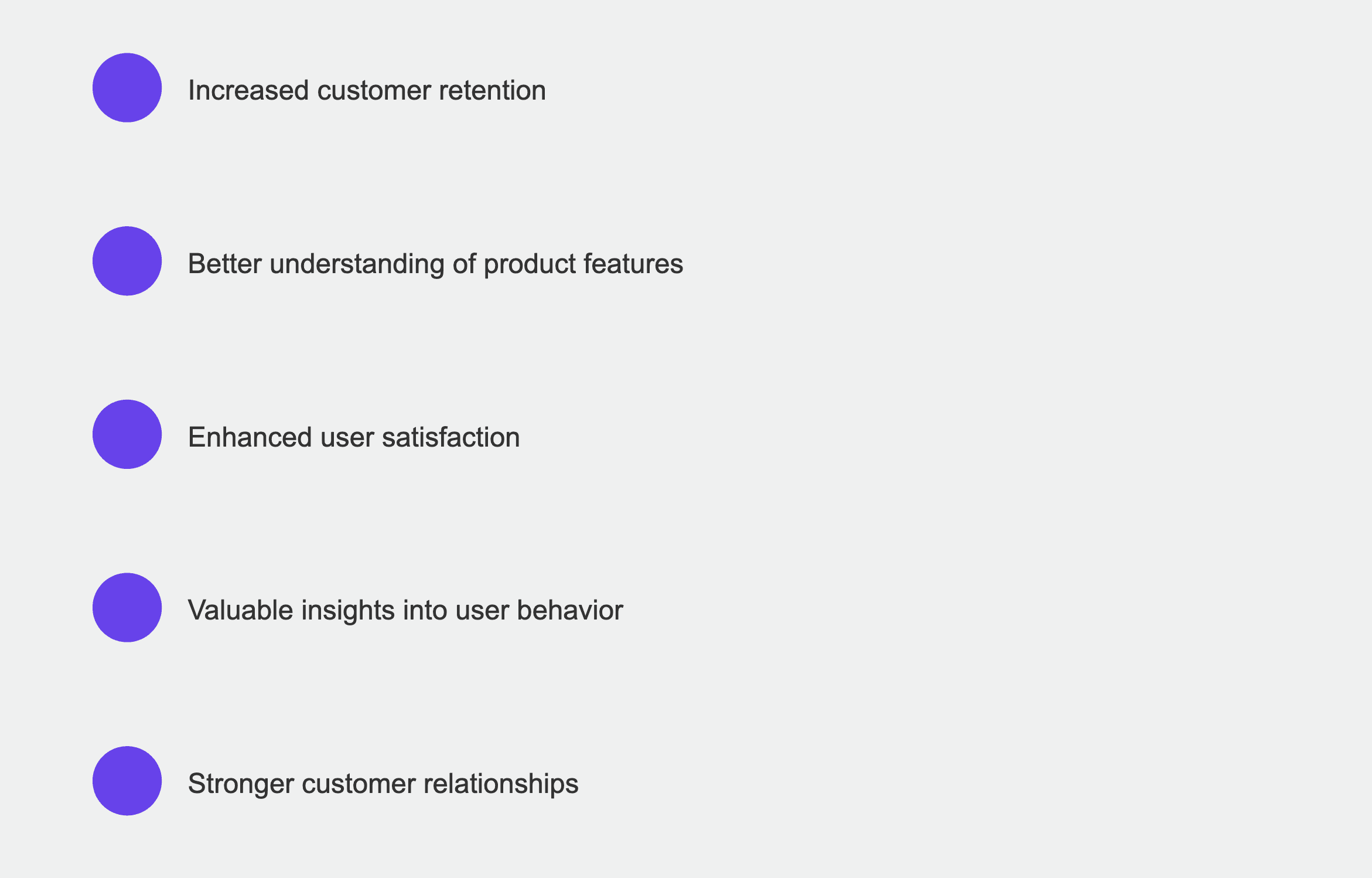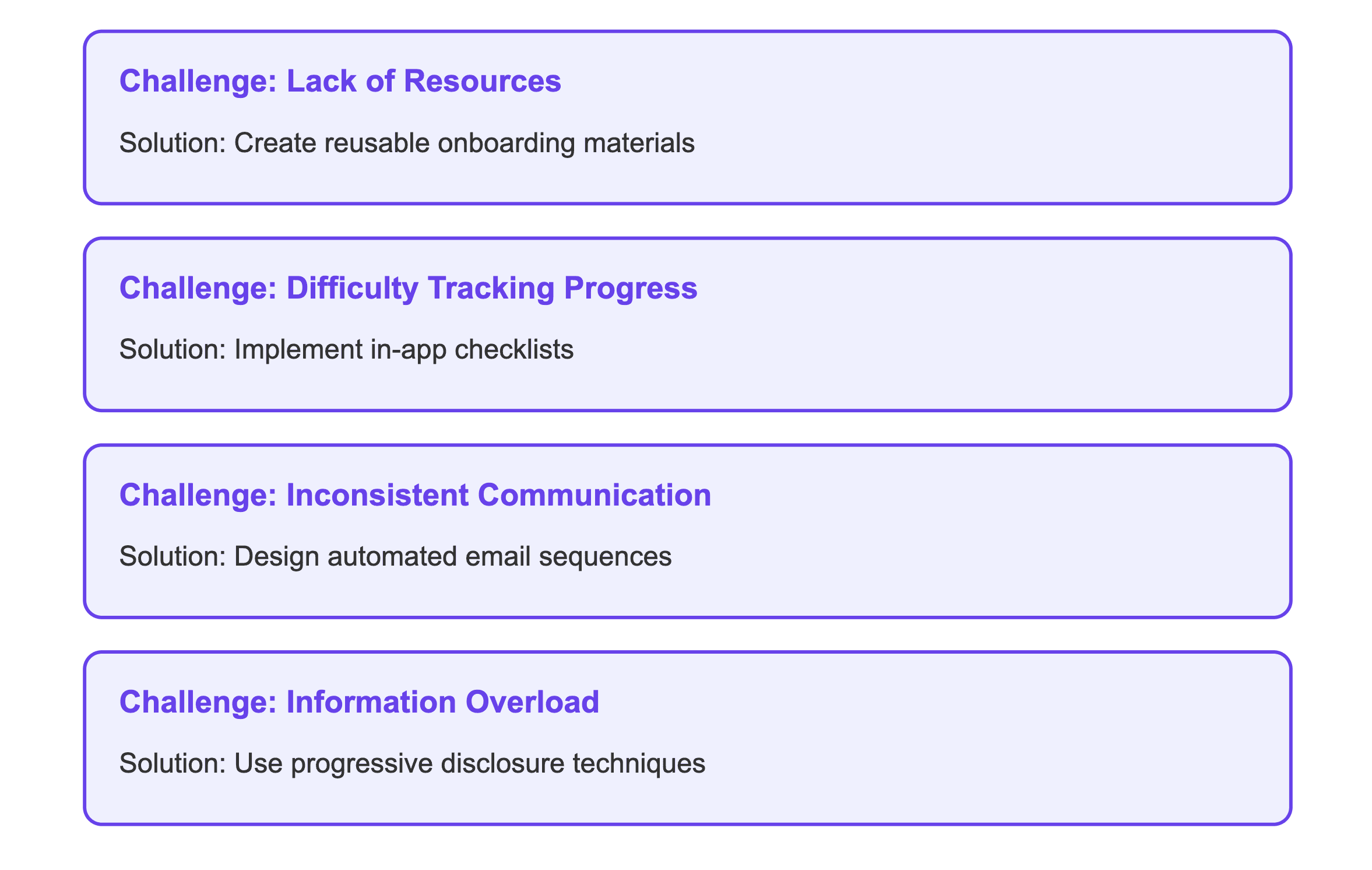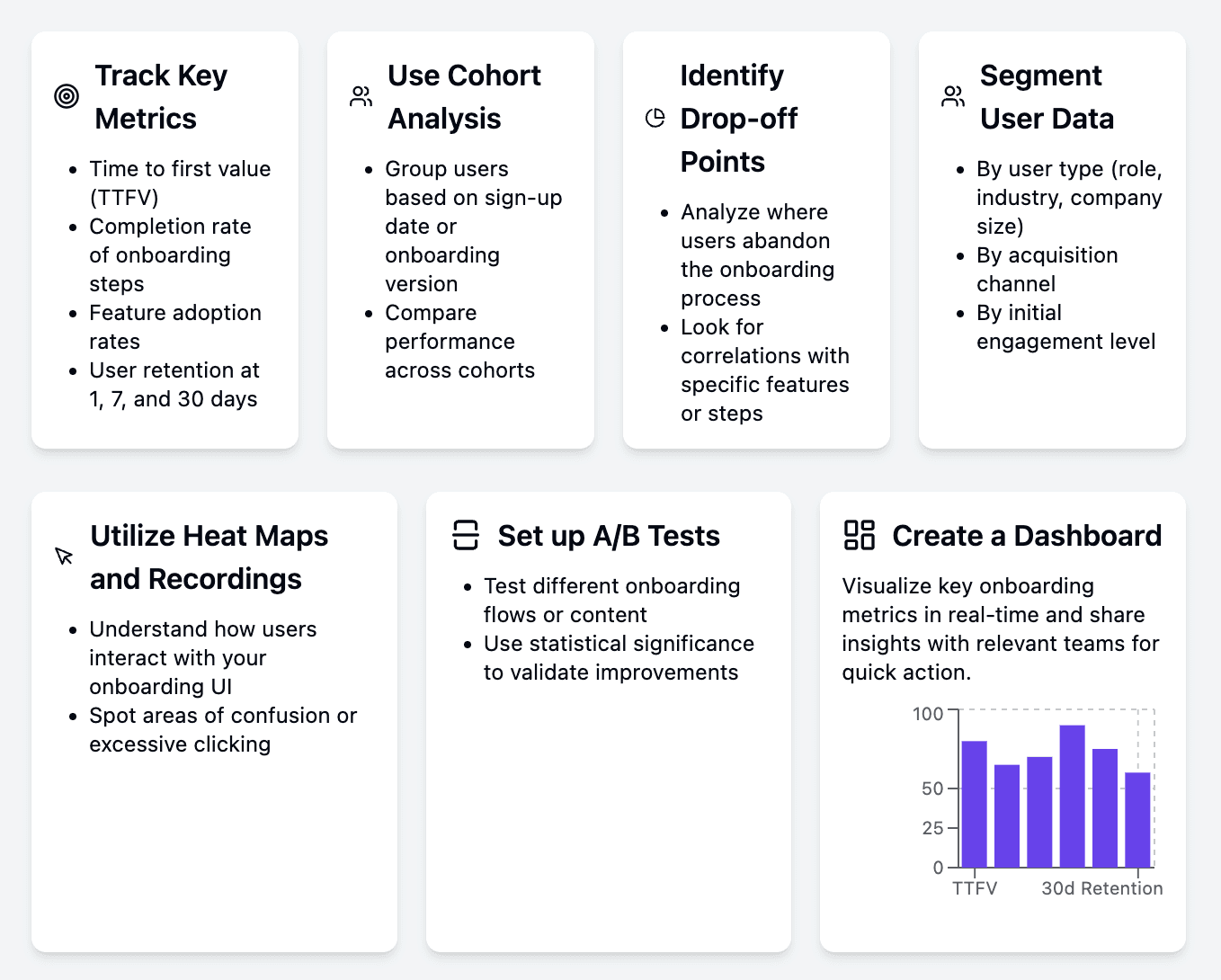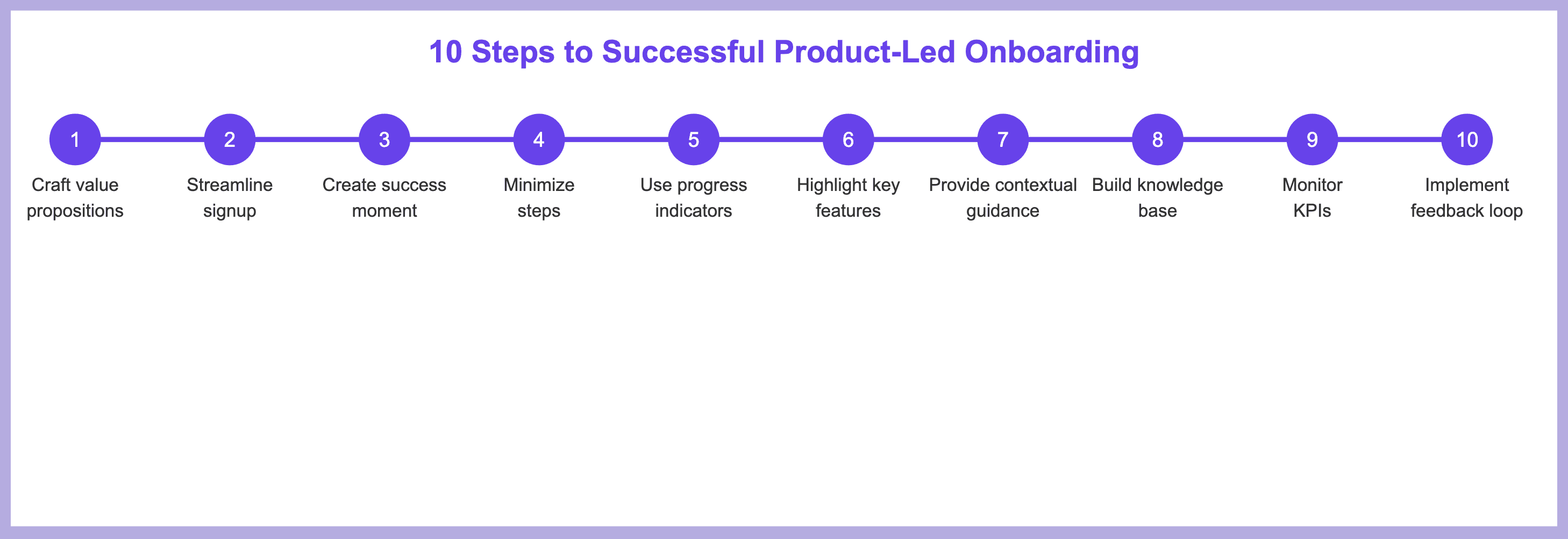
SaaS PLG Onboarding Guide + 10 Steps Onboarding Checklist

by
Wiktoria Slowikowska
Sep 20, 2024
Identify and convert your most valuable users
Sign Up
Onboarding new customers in the SaaS world is a key step that can make or break their experience with your product. A positive onboarding experience can shape the long-term relationship users will have with your product, influencing not only their immediate engagement but also their overall satisfaction and loyalty.
A well-organized onboarding process helps users understand how to use the software effectively, leading to higher satisfaction and retention rates.
Without a clear, efficient onboarding strategy, users may feel overwhelmed, frustrated, or lost, potentially leading to higher churn rates. This checklist will guide you through the essential steps to ensure your customers have a smooth start with your service.
Key Takeaways
Effective onboarding is crucial for customer retention and satisfaction.
Prepare helpful materials like videos and guides to assist new users.
Automate welcome emails to greet users promptly after signup.
Use in-app tips to guide users through key features.
Gather feedback continuously to improve the onboarding experience.
Understanding the Importance of SaaS PLG Onboarding
Why Onboarding Matters
Onboarding is crucial because it shapes the first impression of your software. If users don't grasp how to use your product quickly, they may lose interest and leave. In fact, many studies suggest that users decide whether to continue using a product within the first few minutes of interaction.
Companies must optimize onboarding during the first minutes to improve user engagement, prevent drop-off, and improve conversion. This is why it's essential to deliver immediate value, ensuring that users understand the core benefits of your product as soon as possible.
Benefits of Effective Onboarding
A well-structured onboarding process can lead to numerous advantages:

Common Onboarding Challenges
Despite its importance, many companies face challenges in onboarding:
Difficulty in tracking user progress: Without proper tools or systems in place, companies struggle to monitor how users are advancing through the onboarding process, making it challenging to identify bottlenecks or provide timely assistance.
Lack of resources for training materials
Limited budgets and time constraints often result in inadequate or outdated onboarding resources, hindering the user's ability to learn and adapt to the product effectively.
Inconsistent communication: Fragmented or poorly timed messaging can confuse users and dilute the impact of important information, leading to a disjointed onboarding experience that fails to guide users effectively.
Overwhelming users with too much information at once: The eagerness to showcase all features and capabilities can backfire when users are bombarded with excessive information, potentially causing cognitive overload and discouraging further engagement with the product.

Effective onboarding is not just about teaching users how to use your product; it's about ensuring they see its value right away. This can lead to long-term loyalty and success for both the user and the company.
10 Essential Steps for Successful Product-Led Onboarding: Your Ultimate Checklist

Let's dive into the most crucial elements of a product-led onboarding strategy. This onboarding checklist will help you create an onboarding experience that not only welcomes users but also sets them up for long-term success and engagement with your product.
Craft compelling value propositions
Your value proposition is the foundation of user engagement. It should clearly communicate how your product solves the user's problems or improves their situation. A well-crafted value proposition can be the difference between a user deciding to invest time in your product or moving on to a competitor.
This statement should be prominent from the start—users need to understand why your product matters.Design a streamlined account creation process
First impressions matter, and that includes the signup process. Eliminate unnecessary form fields and steps to reduce friction. A smooth, quick signup process increases the likelihood of users completing registration and moving forward with your product.
Ensure that users can sign up with minimal effort by integrating social sign-ons or pre-filled form fields where appropriate.Orchestrate an immediate "success moment"
By designing an early win for new users, you create a positive association with your product from the start. This success moment should be achievable within minutes of signing up, giving users a taste of the value your product can provide.
This small achievement builds momentum, encouraging users to continue engaging with your product.Minimize steps to initial success
In the digital world, user patience is a scarce resource. Streamline your onboarding process to help users reach their first success moment with as few steps as possible.
This approach reduces friction and increases the likelihood of user engagement. Each step should feel intuitive and purposeful, avoiding unnecessary complicationsImplement visual progress indicators
People love to see how far they've come. Visual progress indicators, such as checklists or progress bars, provide users with a sense of accomplishment and motivate them to complete the onboarding process.
These visual cues can also reduce anxiety by letting users know how much more is left.Spotlight key features aligned with user goals
Not all features are created equal in the eyes of a new user. Highlight the features that directly address their immediate needs or goals. This targeted approach helps users see the relevance of your product to their specific situation.
This way, users can quickly grasp how your product will solve their unique challenges.Utilize contextual guidance
Provide helpful tips and explanations within the user interface, right where users need them. This just-in-time learning approach helps users understand features in context, increasing the likelihood of successful adoption.
Make sure these tooltips are non-intrusive, allowing users to opt-in for more information when needed.Establish a comprehensive self-service knowledge ecosystem
Empower users to find answers on their own. A well-organized knowledge base with tutorials, FAQs, and troubleshooting guides can significantly reduce support tickets while improving user satisfaction and product adoption.
Continuously update these resources as your product evolves to ensure users always have access to the most relevant information.Monitor critical onboarding and engagement KPIs
What gets measured gets managed. Keep a close eye on key metrics such as time to first value, feature adoption rates, and user retention. These insights will guide your ongoing efforts to refine and improve the onboarding experience.
Leverage data analytics platforms to track these KPIs in real-time, allowing you to make proactive adjustments to your onboarding process.Implement a systematic user feedback loop
Your users are the best source of information on what works and what doesn't in your onboarding process. Regularly collect and analyze user feedback to identify pain points and opportunities for improvement. This continuous feedback cycle is crucial for evolving and optimizing your onboarding process over time.
Incorporate regular surveys or feedback prompts to capture user sentiment at different stages of onboarding.
By focusing on these key steps, you can create an onboarding experience that not only welcomes users but also sets them up for long-term success and engagement
Preparing Essential Onboarding Materials
Creating effective onboarding materials is crucial for helping new users understand your product. These materials set the stage for a smooth onboarding experience. Here are some key components to consider:
Creating a Help Center
Develop a comprehensive help center that answers common questions.
Include articles, FAQs, and troubleshooting guides to assist users.
Ensure the help center is easy to navigate and search.
Developing Case Studies
Write case studies showcasing how other clients have successfully used your product.
Highlight specific challenges they faced and how your solution helped them.
Use these stories to inspire new users and demonstrate value.
Producing Introduction Videos
Create short introduction videos that explain your product's key features.
Use engaging visuals and clear language to keep users interested.
These videos can be repurposed throughout the onboarding process.
Preparing these materials is essential for a successful onboarding journey. They help users feel confident and informed as they start using your product.
Designing an Effective Email Sequence
Creating a well-structured email sequence is crucial for successful SaaS onboarding. This sequence helps keep users engaged and informed throughout their journey. Here are the key components to consider:

Remember, the goal is to turn users into happy, paying customers. Focus on the benefits your product offers to help them achieve their goals.
Utilizing In-App Tooltips and Guides
In-app tooltips and guides are essential for helping users navigate your software effectively. These tools enhance user experience by providing immediate assistance right where users need it. Here are some key components to consider:
Welcome Windows
Welcome windows greet users when they first log in, offering a brief overview of the product.
They can highlight important features and guide users on what to do next.
Feature Callouts
Use feature callouts to draw attention to specific functionalities.
These can pop up as users hover over or click on certain areas, making it easier for them to learn about new tools.
In-App Checklists
In-app checklists help users track their progress through the onboarding process.
They can motivate users to complete tasks by showing how far they've come.
In-app guidance is crucial for keeping users engaged and ensuring they understand how to use your product effectively.
Implementing Continuous Feedback Mechanisms
Collecting User Feedback
Gathering feedback from users is essential for improving the onboarding experience. You can use various methods to collect this feedback:

Analyzing Onboarding Data

Once you have collected feedback, it's crucial to analyze the data. Look for patterns and trends that can help you identify areas for improvement.
Focus on key metrics such as time-to-value, feature adoption rates, and user drop-off points. Use data visualization tools to spot correlations between user actions and successful onboarding. Pay special attention to segmenting users based on their behavior and characteristics to uncover insights specific to different user groups.
This data-driven approach allows you to make informed decisions about where to focus your onboarding optimization efforts for maximum impact.
Making Iterative Improvements
Improving your onboarding process is an ongoing task. Use the insights gained from user feedback and data analysis to make necessary adjustments. Regularly update your onboarding materials to reflect changes in your product and user needs. This ensures that your onboarding remains relevant and effective.
Continuous feedback is not just about fixing problems; it's about enhancing the overall user experience. Regular check-ins and updates can prevent small issues from becoming big problems.
Final Thoughts on Your SaaS Onboarding Journey
In conclusion, a well-structured onboarding process is essential for keeping your customers happy and engaged.
By following the steps outlined in this checklist, you can help new users understand your software better and make them feel confident in using it. Remember, the goal is to guide them from their first login to becoming regular users who see the value in what you offer.
A smooth onboarding experience not only reduces the chances of customers leaving but also builds a strong relationship with them.
So, take the time to refine your onboarding process, listen to feedback, and make adjustments as needed. Your efforts will pay off in the long run, leading to happier customers and a more successful business.





